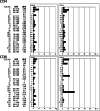Toxic shock syndrome with a cytokine storm caused by Staphylococcus simulans: a case report
- PMID: 33407229
- PMCID: PMC7789174
- DOI: 10.1186/s12879-020-05731-y
Toxic shock syndrome with a cytokine storm caused by Staphylococcus simulans: a case report
Abstract
Background: Exotoxins secreted from Staphylococcus aureus or Streptococcus pyogenes act as superantigens that induce systemic release of inflammatory cytokines and are a common cause of toxic shock syndrome (TSS). However, little is known about TSS caused by coagulase-negative staphylococci (CoNS) and the underlying mechanisms. Here, we present a rare case of TSS caused by Staphylococcus simulans (S. simulans).
Case presentation: We report the case of a 75-year-old woman who developed pneumococcal pneumonia and bacteremia from S. simulans following an influenza infection. The patient met the clinical criteria for probable TSS, and her symptoms included fever of 39.5 °C, diffuse macular erythroderma, conjunctival congestion, vomiting, diarrhea, liver dysfunction, and disorientation. Therefore, the following treatment was initiated for bacterial pneumonia complicating influenza A with suspected TSS: meropenem (1 g every 8 h), vancomycin (1 g every 12 h), and clindamycin (600 mg every 8 h). Blood cultures taken on the day after admission were positive for CoNS, whereas sputum and pharyngeal cultures grew Streptococcus pneumoniae (Geckler group 4) and methicillin-sensitive S. aureus, respectively. However, exotoxins thought to cause TSS, such as TSS toxin-1 and various enterotoxins, were not detected. The patient's therapy was switched to cefazolin (2 g every 8 h) and clindamycin (600 mg every 8 h) for 14 days based on microbiologic test results. She developed desquamation of the fingers on hospital day 8 and was diagnosed with TSS. Conventional exotoxins, such as TSST-1, and S. aureus enterotoxins were not detected in culture samples. The serum levels of inflammatory cytokines, such as neopterin and IL-6, were high. CD8+ T cells were activated in peripheral blood. Vβ2+ population activation, which is characteristic for TSST-1, was not observed in the Vβ usage of CD8+ T cells in T cell receptor Vβ repertoire distribution analysis.
Conclusions: We present a case of S. simulans-induced TSS. Taken together, we speculate that no specific exotoxins are involved in the induction of TSS in this patient. A likely mechanism is uncontrolled cytokine release (i.e., cytokine storm) induced by non-specific immune reactions against CoNS proliferation.
Keywords: Coagulase-negative staphylococcus; Cytokine storm; Staphylococcus simulans; Toxic shock syndrome.
Conflict of interest statement
The authors declare that they have no competing interests.
Figures
References
-
- Centers for Disease Control and Prevention. Toxic shock syndrome (other than streptococcal) (TSS) 2011 case definition. https://wwwn.cdc.gov/nndss/conditions/toxic-shock-syndrome-other-than-st....
Publication types
MeSH terms
Substances
Supplementary concepts
LinkOut - more resources
Full Text Sources
Other Literature Sources
Medical
Research Materials
Miscellaneous




